Growth in the New Year
The new school year always coincides with the Jewish new year, and this turns out to be a good thing: reflecting on ourselves and our desired goals as human beings should include what our aims are as educators for the year and for coming years. This year, I’m also reflecting on a first year at Magen David Yeshivah High School (MDY) — as Chief Academic Officer, I oversee General Studies and the implementation of project-based learning (PBL) across the curriculum — , as well as on the I.D.E.A. School Network’s first year. The Network helps Jewish and independent schools implement PBL and educational innovation, and when Dr. Eliezer Jones, General Studies principal at Valley Torah High School (VTHS), and I won funding from the Joshua Venture Group for the Network, it was deliberately with the idea that the Network’s goals were congruent with the ones we had in our schools. Last year was Eliezer’s first year as well at VTHS, so we both had similar experiences in acclimating to new schools and at the same time using the Network to help spread PBL at our institutions. As we set out on Year 2, I want to share some of the practices we found successful as well as the plans for growth we’re laying out.
Calendar
The truth is, when I came to Magen David, the school had already laid out a PBL calendar for the year: each department was to pick a month and at least one grade in which it wanted to experiment with PBL, and teachers got professional development from instructors at High Tech High — public charter schools with a learning-by-doing philosophy — at the end of the 2013-14 school year and additional PD in PBL at the beginning of the 2014-15 year. The calendar turned out to be a great idea: By the end of this past school year, students had experienced PBL in Art History, Biology, Chemistry, English, History, Jewish History, Jewish Law, Jewish Philosophy, Spanish, Torah, and Talmud classes, and those teachers who had become enamored of PBL tried it out in all sorts of large and small ways throughout the year.
What a Scandal!
One of the most successful and inspiring PBL units of the year was the English department’s school-wide “Scandal” day. English Department Chairperson, Mrs. Rachel Harari, and her talented department, not only carefully planned the day — in which students were divided into PR “companies” and given a person or entity that needed an image rehabilitation — the teachers also did a run-through of the day beforehand, so they could troubleshoot any problems that may have arisen. The practice of doing a project before the students is one English department teacher, Mrs. Roxanne Maleh, learned about when she and a group of Magen David educators joined the I.D.E.A. Schools Network on a trip to High Tech High in February 2015. To learn more about the amazing Scandal PBL Day, as we like to call it at Magen David, watch this video, created by Ari Mendelow, who’s part of the I.D.E.A. Schools Network Creativity Team:
PBL in Jewish History
Immediately after last year’s August PD, Mrs. Frieda Cattan, a Jewish history teacher at Magen David, decided to design her course curriculum around the driving question of “How did we as Jews get here today?” Smaller driving questions drove smaller units within the curriculum; for example, students learned how to identify important artifacts for museum exhibits, as they worked in groups to argue why an artifact they had been assigned from the ancient Near East could be considered the most important one of its day. Students presented artifacts such as the Cyrus seal; Nehemiah’s wall; the four-room house; Ezra’s scroll; and more to a museum curator from the YU Museum. She gave important feedback to the students about the content of their presentations and their presentation styles. This year, Mrs. Cattan is building on her PBL curriculum from last year by engaging the help of the YU Museum right away. The museum has already emptied an exhibition case for the students and will guide them as they decide which artifacts they should select as the ones to properly represent different eras in Jewish history.
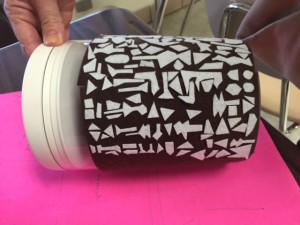
Students in Mrs. Cattan’s 2014-15 Jewish history class spontaneously decided to create simulations of their artifacts. This year, Mrs. Cattan will require students to do so and provide a rubric for this creative element of the PBL unit. Pictured here is a student version of the Cyrus Seal.
Sukkah PBL Day
Another project that became more fully developed from last year to this one is Rabbi Joseph Esses’ Sukkah PBL unit: last year, Rabbi Esses pioneered the project in his Talmud class. Students worked in pairs — in chevruta — to learn different laws about kosher and non-kosher Sukkoth. Then each group built a kosher and non-kosher version of the Sukkah law they had studied and presented their work to the school before the holiday. This year, the entire school partook in the activity: on the last day before Sukkoth vacation, Friday, September 25, the school gym became a wood shop class, the cafeteria became an arts workshop, and students worked all over the school in different classrooms on filming videos and writing essays for the project. The students had conducted research on the laws of different Sukkoth and on Biblical themes of the holiday the day before; on Friday, when they arrived in school, they were told how they were going to put their research to use! One really fun part of both the Scandal and Sukkah PBL days is the element of surprise: students come to school on the day of the school-wide PBL days and are then gifted with an incredibly fun learning experience that is hands-on, creative, and exciting. What a way to break for the Sukkoth vacation: on a high from a project that connects hand, head, and heart and that gets the entire school involved in the learning. Here are some highlights from the day:
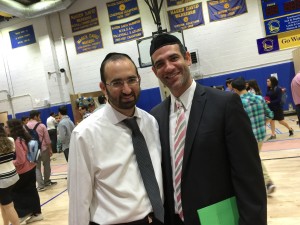
Rabbi Joseph Esses, right, pioneered the Sukkah PBL day last year, and Rabbi Joey Haber, left, worked with Rabbi Esses to bring the project to the entire school this year!
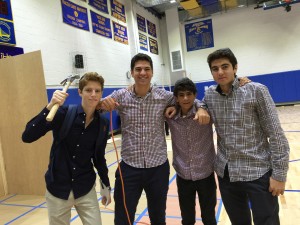
Students built 11 types of Sukkoth in 3 hours, including a double-decker Sukkah, a round Sukkah, a Sukkah with a slanted wall, a Sukkah with a wall with vertical slats and a Sukkah with a wall with horizontal ones.

These boys are building; other students made time-lapse videos and commercials, while still others wrote essays and designed the decorations, which had to unite the law of the Sukkah and the Biblical theme.

“Amazing” was how one student described the day; we love learning that causes this kind of smiling!
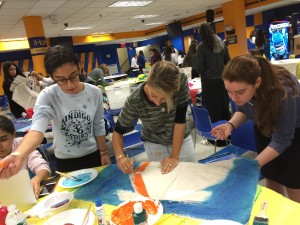
Part of the fun of the PBL days is that everyone gets a chance to get creative — even the teachers. In the center there is Mrs. Roxanne Maleh, one of the school’s English teachers.

The Sukkah with a wall with vertical slats.

Part of the design challenge for the students was to create a Sukkah that connected its decorations with the law of the Sukkah and the Biblical theme they were assigned. This Sukkah, pictured in the above two photos, has a wall partly made up of vertical boards. The group also had to research Aaron, Moses’ brother and one of the members of the Ushpizin, a group of Biblical figures, one of whom “visits” the Sukkah on each of the nights of the holiday. Since Aaron is associated with peace-making, the group building and decorating the Sukkah worked together to create the design theme, which plays off of the idea of the vertical boards by welcoming Jews of all stripes to the hut.
Year 2: Calendar and Interdisciplinary Learning
Though clearly the PBL calendar worked well last year, the truth is, Magen David has moved to a different place this year. The teachers don’t view PBL as something that’s going to start and finish by a certain date. Instead, the teachers have embraced a more fluid notion of how to implement the pedagogy, realizing that they have to incorporate it organically into their courses. In fact, on the third day of PD this year, one Magen David dedicated solely to PBL, the General Studies department decided they wanted to create interdisciplinary themes they could weave PBL units into from all courses. The departments will be studying their syllabi throughout the year and working with the Judaic Studies department to determine the most effective themes for each grade.
Of course, that doesn’t mean PBL is on hold for the year. Quite the opposite. In fact, one important change we made to the curriculum, one we were energized to do by our visit to High Tech High, was to begin to combine English and History courses into one Humanities class. We’re piloting the interdisciplinary class in the 9th and 10th grades, with Mrs. Roxanne Maleh teaching the freshmen and Mrs. Kim Djouejati teaching the sophomores. Creating a Humanities class allows us to cover course curriculum in a more thoughtful and deliberate manner, by using historical and literary texts that are aligned and that support each other and that the teacher can organize under a driving question. For example, using the evolution of civilizations and an exploration of how power structures develop, Mrs. Maleh will be asking her students to consider what makes a society great, what gives people power, and how do we stand up to power if we believe it is being abused. In short, she is asking the students how they can be upstanders. (We want to point out here an important characteristic of PBL: that it’s part of affective learning and development; the PBL units participants designed at the Sandbox also ended up contributing to social and emotional learning. PBL is about whole-person learning.) Though not all the freshmen and sophomore English and history classes have been combined, even the ones that are not are benefitting from the conversations now flowing freely between the two departments.
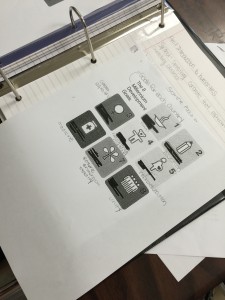
Mrs. Kim Djouejati’s sophomore Humanities class began by considering the UN’s 8 Millennial Development Goals

Finally, students developed their own eight goals for the year. English teacher Mrs. Stephanie Shamah developed this ice breaker last year, and she and Mrs. Djouejati refined it for this school year. One practice becoming very common at Magen David is launching the school year with a creative ice breaker that ties into a course’s curriculum and the year’s or a unit’s driving question
Built-in Innovation Time
Last year, Magen David adopted a modified block schedule, something Stanford professor Denise Pope recommends; check out the new book she co-authored, Overloaded and Underprepared, in which she and her colleagues offer different suggestions for making the school day more manageable for students. The teachers at Magen David have definitely been benefiting from the block schedule and have found that they have to modify their teaching methods to accommodate the block; teaching a frontal lesson for 80 minutes is just not feasible. Many schools implementing PBL employ a block or modified block schedule, but another feature that helps foster pedagogical change is common planning time. At the High Tech High schools, teachers meet every morning for an hour. So far, that’s not possible at Magen David, but Rabbi Saul Zucker, Magen David’s Principal, has added a weekly common planning time period for the teachers. The fact that the teachers know they can consistently meet ensures that the large changes we want to make, ones that need time to incubate slowly, can be done in a professional, thoughtful manner.
Privileging Creativity
One comment that resonated at the East Coast Summer Sandbox was made by Mrs. Marjorie Hirsch of Torah Academy of Bergen County. At the end of the two-day conference, she said she was struck most by how PBL “privileges creativity.” By actively inserting creativity into the curriculum and giving it rubrics as we would any other skill we want the students to master or knowledge we want them to have, we are putting it on an equal standing with other parts of our coursework. An emphasis on creativity is definitely a large part of the I.D.E.A. Schools Network ethos, of PBL, and of the schools the Network is working with. In fact, at the 2014 Summer Sandbox, educators had to use art supplies to create a representation of what school looks like to them. One group showed that in the center of school were classrooms and classes and on the outskirts were the opportunities for passion-based learning and creativity that the traditional classroom often doesn’t typically privilege. Our aim is to continue to ask schools how they might bring passion-based learning and creativity into each and every classroom. We love Maker Spaces, Innovation Labs, Idea Boxes, whatever you want to call them. In fact, we love them so much, we think they need to be part of the everyday classroom experience. This past year, Ari Mendelow actually created a video for the Network that challenges us to think about a Creativity Standard and about engaging in more outside-the-box thinking:
So creativity is definitely an area we want to continue privileging this year.
To that end, we make sure that one element we include in all of the Network’s workshops and conferences is art supplies. Simply by putting supplies in front of participants we see that they become creative, and when they become creative, they naturally pass that onto their students. Here’s how it worked at the Sandbox and at Magen David:

This year we also raffled off books that sparked creativity, ones that included Invent to Learn, Creativity, Inc., Makers, and Creative Schools. We love how excited participants got about the books they won!
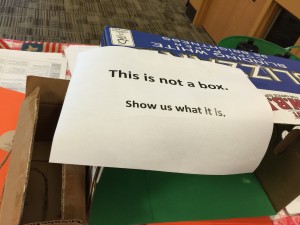
Yeshivat Noam’s Aliza Chanales and Shira Greenspan, Facilitators at the East Coast Sandbox, challenged participants to get outside the box in this spin on the cardboard challenge, an activity that’s become very popular in schools.

We saw this cardboard gorilla at the Philadelphia Zoo over the summer. We challenge you to create a cardboard challenge that ties into your curriculum and adds value to what you’re teaching.
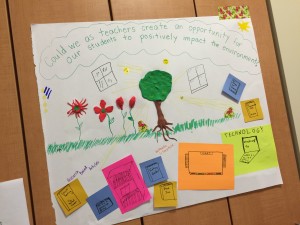
Participants created this poster to feature their driving question: Could we as teachers create an opportunity for our students to positively impact the environment? The participants hadn’t been asked to use supplies, but we find when they’re on the tables, participants often use them even when they’re not asked to. What does that say to you? What would happen if you did that in your classrooms?
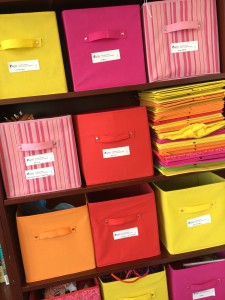
At Magen David, we don’t create one space where art or tech or other media are centered. Instead, we make supplies, tech, and media available to all teachers — and give them training on how to use them — so they become an organic part of the classroom.
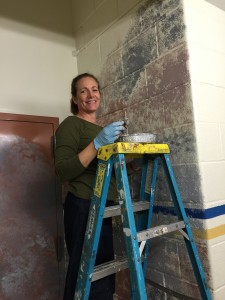
One addition to our school last year was a world and Jewish history stairway timeline. Conceived of by — once again — Rabbi Esses, all teachers and students can add to the timeline important dates and events. To start the year, Mrs. Natalie Greenberg, Magen David’s art teacher, paints a wall to be the background for the “Lascaux cave.” Her art history students will add the figures, and Mrs. Maleh’s Humanities class will add figures as well, mimicking the way cave artists added to the caves at different times.
Connecting with Others
One valuable part of our growth as learners is constantly being able to connect with others, whether it’s other schools in the Network, ones we work on PD with, educators in our PLN, or folks we meet on social media. At Member School Yavneh Academy, for example, we’ve been so impressed with the extensive research Director of Educational Technology ChanI Lichtiger and her team did in the area of Maker Spaces. When the school launched one last year, it included a multitude of opportunities for all students to experience the joy of Making. Member School ADAT Ari El has not only launched an Innovation Lab this year, it also has a wonderful new reading space — yes, slow learning and reading are still important parts of school! — and it has an exciting focus on Design Thinking. In fact, Head of School Dr. Johannah Sohn is combining her PBL PD with Design Thinking questions she wants her teachers to consider and create. One question she wants her teachers to ask themselves is how might they redesign their classroom space to make learning more personalized and collaborative? If you want to think about block scheduling and reshaping your calendar so it allows for more project-based and deep learning, then check out the work being done at Fuchs-Mizrahi. Our contact there is Rabbi Yehuda Chanales, who is part of my PLN, and I always like hearing about his school’s innovations. Of course, check out the super-awesome Aliza Chanales and Shira Greenspan, whose work at Yeshivat Noam, the East Coast Sandbox host, is always inspiring and creative. Here’s a sample PBL unit by Aliza, about Superhero Elements! And if you’re struggling to find a way to combine PBL with an AP curriculum, get in touch with Dr. Eliezer Jones, at Founding School Valley Torah High School, who’s piloting PBL in the AP Psychology class he’s teaching this year. I personally am looking forward to being part of an Educational Leadership program at High Tech High this coming year, with my Magen David colleagues, Rabbi Michael Bitton, Mrs. Sabrina Maleh, and Mrs. Esther Tokayer.
Change can sometimes feel overwhelming, but connecting with others is a way to make it fun and more approachable. That’s why we value the fact that team-building and collaboration are such key parts of PBL, not only in the classroom but outside of it as well.
Reflection
Reflection is also a crucial component of PBL, and having the High Holidays coincide with the beginning of the school year means we begin our year in a contemplative mode that naturally leads to our considering the successes and challenges of the previous year and a commitment to growth in the new one. The Network is excited about the opportunities it had to foster growth in the schools we worked with and about the possibilities that lie in the year ahead. There are so many new ways for educators to learn and develop, and we hope you’ll share with us the ways you find to explore, get creative, work with others, and make learning authentic and real for yourselves and your students. Have a great year!
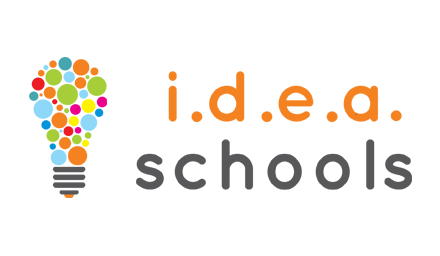
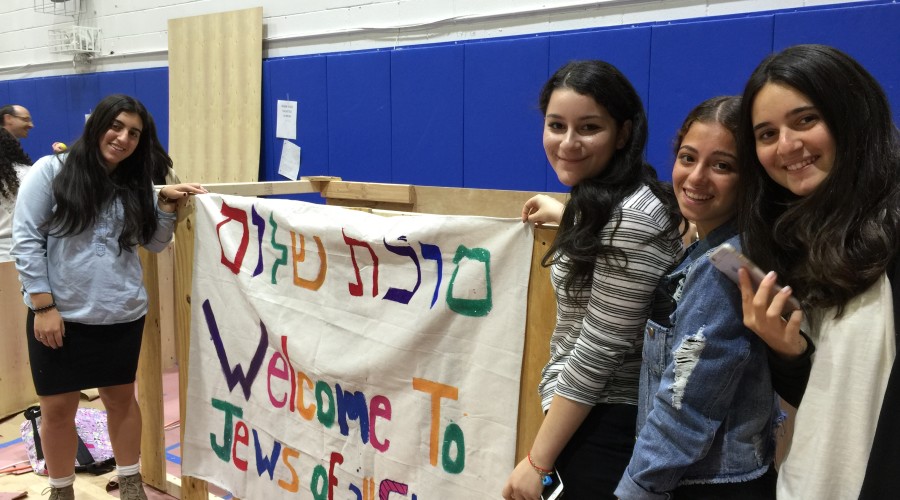
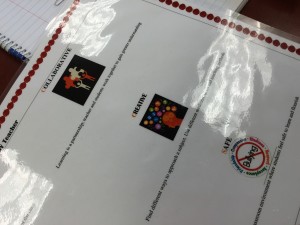
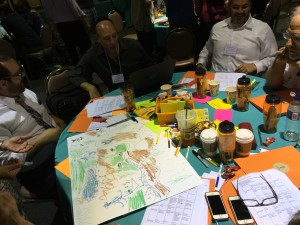
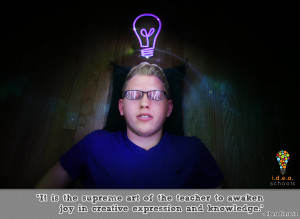
Recent Comments